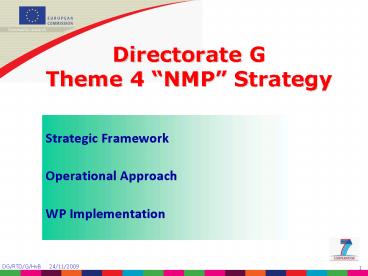Directorate G Theme 4 NMP Strategy PowerPoint PPT Presentation
1 / 11
Title: Directorate G Theme 4 NMP Strategy
1
Directorate GTheme 4 NMP Strategy
- Strategic Framework
- Operational Approach
- WP Implementation
2
NMP Strategic FrameworkNMP Policy Focus -
Industrial Technologies
- Main policy objectives
- Article 163 of Treaty
- Strengthening S/T base of industry
- Industrial competitiveness
- Objective Barcelona, Lisbon ,Göteborg
- Growth and Employment
- Sustainability and Climate Change
- Safety and improved working conditions
- European Research Area (ERA)
- Framework Programme and Specific Programme as
basis
NMP OBJECTIVETo contribute to transformation of
industry from resource-based to knowledge-based
3
Europes RTD intensity as world competitor
4.74 IL
GDP
RTD intensity in world regions
3.17
2.99
2.67
1.84
1.07
Source Key RTD Figures 2007 on Science,
Technology and Innovation - Towards a European
knowledge Area
4
EU RTD funding sources as world competitor
Source Key RTD Figures 2007 on Science,
Technology and Innovation - Towards a European
knowledge Area
5
NMP Strategic FrameworkNMP Life Cycle Strategy
Knowledge deployment New HVA products/Services
Knowledge generationNew Ideas
New systems
Applied research / Demonstration / Validation
Industrial application
Long term applied research
ERC
Basic research
Future andEmerging Technologies
Market
Open topics for broadly defined range of
applications
Focused topics with precise fields of application
NMP
Breakthrough technology
Step change
Enabling technologies
Technological innovation
6
NMP Operational ApproachPrioritisation through
Dialogue and involvement of all partners
Policy, Industry, Research
- Policy input
- Industry, Environment, Social Affairs,
Healthwithin the Commission and the Member
States - Strategic Research Agendas from European
Technology Platforms - Society / Industry / user driven
- Strong involvement of Research Establishments /
Academia - Priority for multi-sectoral benefits /
applications - Foresight studies
- Advisory bodies / Stakeholders / Public
Consultations - Portfolio of on-going projects
7
NMP Operational ApproachEnsuring effectiveness -
Industrial Focus
- Focusing on where European value added is the
highest - Industrial partner participation is key for
all research activities - SMEs importance in generating value added in
the networks - Oriented to multi-sectoral benefits or cluster
of industries with potential commonalities - Modernised traditional industries (such as
textiles, ) - Scale intensive industries (such as
automotive,) - New science-based industries (such as
biotechnology, ) - New supply industries (such as renewable
(paper,...))
8
NMP WP Establishment Call Main Features
- In the first two (2007 and 2008) calls
- Strategic use of funding schemes (one scheme
per topic) - Calls by funding scheme (Large, Small, SME,
CSA) - Budget allocation by call (NOT by Activity /
Area) - Two stage submission for all projects except
CSA - One evaluation panel per topic
- Subsequent calls
- Strategic use of funding schemes (one scheme
per topic) to be continued - Calls by funding scheme (Large, Small, SME,
CSA) but, also - Cross-thematic initiatives e.g. Biorefinery
- PPP e.g. Factory of the future
9
ImplementationPPP FoF
Focus
Strategy
Assuring the Future of Manufacturing in Europe
by High Adding Value
- The new European model of production system for
the factories of the future (e.g. transformable
factories, networking factories of excellence,
learning factories) - ICT based production systems and high quality
manufacturing technologies capable to optimize
their performance with a high degree of autonomy
and adaptability for a balanced combination of
high throughput and high accuracy production. - Sustainable manufacturing tools, methodologies
and processes that have the capability of
cost-efficiently shaping, handling and assembling
products composed of complex and novel materials
New Products
Todays Products
Todays Markets
New Markets
10
ImplementationPPP E2B
Focus
Strategy
Tools Tools for designing, measuring and
assessing energy efficiency particularly at
district level. The building envelope design,
development and manufacturing processes of
components for new and retrofitted envelopes
Systems and equipments components systems
to ensure that buildings work during the whole
lifetime delivering initial performances Environme
ntal technologies For assessing the Energy and
Environmental performance of buildings and
districts (including Cultural Heritage). Standardi
sation Pre-normative research, standardisation
of components and systems Business models
including clients and user's requirements, the
entire supply chain, legal and financial
framework, technical aspects, geographical and
local features and the whole life cycle.
Three steps strategy 1- Reducing the energy
consumption of buildings and its negative
impacts on Environment 2- Buildings cover their
own energy needs 3 -Transformation of buildings
into energy provider preferably at district
level
11
ImplementationPPP GC
Focus
Strategy
- Three prong strategy
- All road vehicles passenger cars, buses, urban
vehicles and trucks - Infrastructure (smart grids, distribution
recharging of systems) - Logistics, co-modality, and ITS
- Heavy duty vehicles ( Internal combustion
engines, vehicles technologies for energy
optimisation). - Road and urban transport electrification.
- Logistics, co-modality and Intelligent Transport
Systems technologies.

